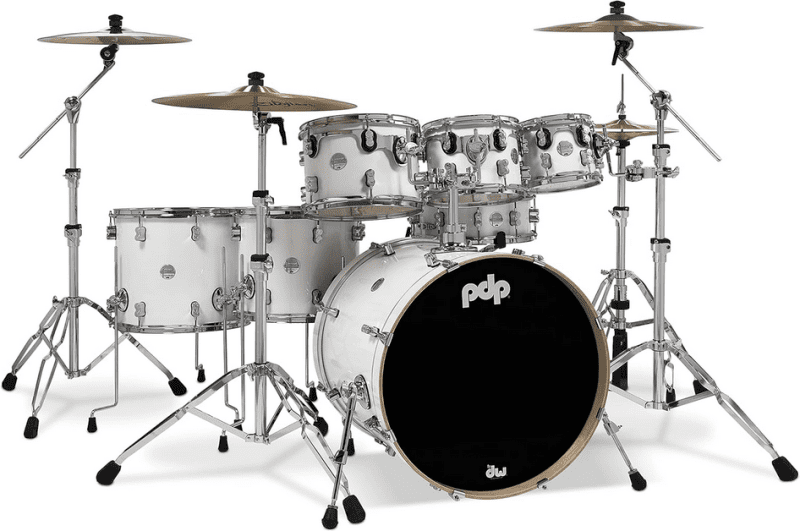"Beat by Beat: Essential Drumming Patterns for Drummers"

Drumming isn't just about keeping time—it's an art form that requires a mastery of patterns to bring music to life. Whether you're laying down the backbone of a rock anthem or the subtle nuances of a jazz piece, knowing essential drumming patterns is what separates the novices from the seasoned pros.
As a drummer with years of experience behind the kit, I've learned that these rhythms are more than beats; they're the language we use to communicate with fellow musicians and audiences alike.
Every drummer starts somewhere, and it begins with locking in those fundamental grooves that are ubiquitous across genres. From commanding attention with thunderous bass drum kicks to weaving intricate hi-hat subtleties, understanding these essentials is your first step towards rhythmic greatness.
Keep reading for insights into patterns that will not only refine your skills but also expand your musical vocabulary. Get ready—your journey toward drumming distinction starts here!
Key Takeaways
- Drummers should start with basic patterns like the 8th note groove and build up to complex beats.
- Using techniques like consistent strokes and playing along with a metronome helps master each pattern.
- Essential drumming patterns are used in many music genres, from rock and jazz to reggae and disco.
- Practice is key; daily rudiment exercises improve overall drumming skills.
- Learning various drum beats enhances a drummer's ability to adapt to different musical styles.
The Importance of Mastering Essential Drumming Patterns

Moving from the basics, let's dive into why nailing drum patterns is key. Mastering these beats gives you a strong foundation in music. Think of drumming like building a house. Without strong patterns, your grooves might fall flat, just like a house without good bricks! Essential drumming patterns are your bricks for creating rock-solid rhythms.
These beats are not just important; they're everywhere in music! From jazz to hip-hop, drummers use them to keep the band tight and the audience moving. Learning and practicing these patterns boosts your confidence behind the kit.
It makes you ready for any song or jam session that comes your way! Plus, knowing these rhythms helps you speak the universal language of percussionists around the world.
10 Common Drum Beats Every Drummer Should Know

Dive into the heartbeat of rhythm as we explore 10 drum beats that are the bread and butter for any serious drummer. From groove-laden 8th note patterns to complex jazz ostinatos, these foundational rhythms aren't just exercises—they're your passport to musical fluency across every genre.
Standard 8th note groove
Hitting the drums on a standard 8th note groove sets the foundation for countless songs. Here's how you can master it: start with your hi-hat, playing steady 8th notes. Next, add a kick drum beat on the 1st and 3rd counts of each measure.
Don't forget to hit the snare drum hard on the 2nd and 4th beats; these are your backbeats. This pattern is all about precision and keeping time.
Practice this groove slowly at first, then gradually speed up as you get more comfortable. Make sure each stroke is consistent in volume and tone for that solid rock feel many bands love.
Listen to different songs across genres; rock, pop, country—they all use this essential rhythm.
Keep working on this key part of drumming basics until it feels like second nature. It's your stepping stone to more complex patterns! Work those hi-hats smoothly while making sure your kicks and snares have punchy dynamics—they're what make or break this rhythmic backbone.
Always remember that mastering this beat will open doors to learning exciting variations later down the road in your percussion mastery journey—a true sign of drummer skills! So keep tapping away at those hi-hat cymbals, perfecting every note until you've nailed that driving groove that gets people's feet tapping.
Four to the floor
Four to the floor is all about that steady beat. Every kick drum thumps on each beat of the measure, creating a powerful and danceable rhythm. This pattern drives many disco and electronic songs, filling dance floors around the world.
It's a staple for every drummer because it keeps the music grounded and pulsing forward.
Master this, and you'll have crowds moving in no time. Get your bass drum pedal ready; it's going to do some heavy lifting with this essential groove pattern. Up next, let's dig into the shuffle groove – it will add a whole new swing to your repertoire!

Shuffle groove
A shuffle groove swings the beat and lights up a song. It's all about that laid-back, bouncy feel you get in blues, rock, and other styles. Picture drummers like Bernard Purdie or John Bonham; their hands create magic with this pattern.
They play it smooth by dragging the rhythm gently, making each note dance between straight and swung.
To nail a shuffle groove on your drum set, start slow and focus on feeling the groove deep inside. The trick is to master when to hit those shuffled eighth notes just right – not too stiff, not too loose.
Your snare drums must snap while your hi-hat cymbals do a delicate dance. Keep practicing until your sticks flow easily across the skins and cymbals, crafting grooves that make people want to move.
With every beat you perfect, you sharpen your dynamic rhythms and show off serious percussive finesse!
16th Note Groove
The 16th note groove gets your feet tapping and energy flowing. It's all about quick, precise hits on the snare and hi-hat. You'll find this beat in a lot of modern music—it keeps listeners dancing.
To play it right, you have to hit the drum lightly but rapidly.
Start slow with this pattern and build up speed as you go. Your stick control needs to be tight for those fast notes! Use a metronome to keep steady while practicing. This groove can be tricky because you're playing four notes for every beat.
Feel the rhythm, let your sticks bounce, and get that groove solid. Focus on keeping your arms relaxed even when the tempo picks up. The more relaxed you are, the smoother it will sound—and feeling smooth is key with 16th-note grooves! Keep practicing until it feels like second nature; then throw in some drum fills to make it pop.
12/8 groove
A 12/8 groove swings with a smooth, flowing rhythm that feels like waves rolling in. This pattern is essential for drummers who want to master blues, soul, and some rock music. It's based on a compound triple meter where each beat is divided into three notes.
Imagine counting "1-2-3" evenly under each number when you're tapping your foot to the pulse.
Your sticks will dance over the drum kit as you hit those triplet subdivisions. They give this groove its distinctive bouncy feel. Play around with accents and dynamics to make it come alive.
Keep your hi-hat or ride cymbal steady while your snare and bass drum create depth and texture underneath.
Up next: Get ready for the Motown groove!
Motown Groove
Shifting from the rolling feel of a 12/8 groove, drummers glide into the classic Motown groove. This beat has a steady backbeat and often incorporates subtle syncopation on the snare to give it that signature bounce.
Picture the drummers for artists like The Temptations and Marvin Gaye; they mastered this smooth, infectious rhythm that's essential in soul and R&B music. To nail the Motown vibe, work on playing less aggressively yet keeping time impeccably.
The hi-hat typically maintains eighth notes while strong accents come through on the two and four beats with your kick and snare drums. Syncopated hits or ghost notes add extra spice without overwhelming the song's flow — precision is key here.
Remember, it's not just about what you play but also what you don't; creating space within these grooves allows other instruments to shine through as well. Keep practicing those dynamic nuances until your beat sits perfectly in any old-school jam session or modern hit striving for that timeless Motown sound.
Reggae Groove
Moving from the Motown groove to Reggae, drummers tap into a whole different vibe. The Reggae groove is all about feeling and rhythm. Think of the classic beats in Jamaican music—this is where you find that laid-back yet powerful sound.
Your bass drum hits on the third beat, giving it that signature delayed sensation. Snare and high hat play key roles too, with an emphasis on the off-beats or upbeats for that distinct reggae pulse.
Drumming to reggae teaches precision and control because every stroke counts. Keeping your sticks low helps maintain this style's relaxed feel while staying precise. This groove often uses simpler kick and snare patterns but demands a drummer to be rock-steady with timing.
Playing reggae will boost your ability to create deep pockets in music—and that’s essential for any drummer wanting to make their beats truly irresistible!
Disco Groove
Disco groove beats make you want to dance. The bass drum keeps a steady four on the floor, hitting every beat. Hi-hats usually play off the bass with an open and closed pattern that gives life to the rhythm.
This infectious beat took over in the 70s and still gets people moving today.
It's all about that consistent pulse which makes disco so catchy. Drummers mix in snare hits to create a backbeat that stands out. Throw in some syncopation for variation, and you have the quintessential disco feel.
Mastering this groove can give drummers a solid foundation for playing disco and many other dance genres.
Nail down those hi-hat techniques—striking just right for crisp openings and closings adds finesse to your groove mastery. Emphasis on every quarter note is key; let it drive the energy of your playing as you lock into disco's rhythmic heartbeat.
Jazz Ostinato
Jazz ostinato is a must-know for drummers who love the smooth and complex rhythms of jazz music. The pattern focuses on a repeated rhythmic phrase, typically played with the ride cymbal or hi-hat.
This groove helps maintain the swing feel that's classic to jazz while providing a steady pulse. Drummers often use their bass drum and snare to add accents and syncopation, giving life to the ostinato.
Playing jazz ostinatos requires precision drumming and an ability to keep time impeccably. It allows drummers to explore polyrhythmic exercises within a musical piece, adding depth and texture.
Mastery of this technique opens doors to creative drumming avenues like comping—where you play around with rhythm under soloists—and improvising unique drum patterns that can define your signature style.
Developing fluency in playing jazz ostinatos takes dedicated practice focused on mastering rhythmic control and learning essential beats. Trying out different ride patterns over simple duple meters can be fun for experimentation.
Keep it groovy by varying dynamics with your sticks and maintaining that cool jazz vibe throughout your performances!
Half-time Shuffle
The half-time shuffle is a go-to for drummers aiming to slow things down while keeping the groove deep. Picture the smooth, laid-back feel of hits like "Rosanna" by Toto or Led Zeppelin's "Fool in the Rain." This pattern hinges on a triplet feel, with ghost notes and a backbeat that gives it a unique swing—think of it as a slowed-down version of the standard shuffle.
Your kick drum keeps a steady pace while your snare adds those subtle notes almost felt more than heard.
Master this groove and you'll bring out that silky, chilled vibe in ballads or R&B tracks. Getting it right means working on stick control and playing softly but firmly where needed.
Once you've got the half-time shuffle down, listeners will nod their heads to your beat without even realizing why they're so drawn into the rhythm. Next, let's dive into learning how to play common drum beats..
Learning How to Play Common Drum Beats
Diving into the rhythm, and learning these drum beats is more than just memorization—it's about feeling the pulse and bringing it to life with your sticks. From grasping the basics to finessing each nuanced hit, we'll guide you through techniques that transform patterns into second nature for any drummer aiming to groove like a pro.
Tips and Resources for Beginners
Starting your drumming journey is exciting. Here's how to master the basics and find helpful resources:
- Get comfortable with your drumsticks. Hold them with a relaxed grip to keep your strokes even and prevent hand fatigue.
- Practice basic strokes. Work on hitting the snare drum with consistent force to improve your precision.
- Start slow with essential rudiments. Focus on mastering single, double, and paradiddle strokes to build your skill set.
- Set up your drum kit properly. Adjust the height of your drums and cymbals for easy reach and better control.
- Use a metronome. Keep time with this tool to develop a strong sense of rhythm and tempo.
- Play along with music tracks. Choose simple songs at first to help you learn different groove patterns.
- Watch video tutorials from pro drummers. These can provide visual guidance on drumming techniques and styles.
- Join online forums or groups for drummers. Connect with others for tips, support, and motivation.
- Read books about drumming fundamentals. They often include exercises for improving technique and rhythm mastery.
- Take lessons from an experienced teacher. This investment can fast - track your learning and correct bad habits early on.
Techniques for Mastering Each Beat
Mastering drum patterns takes practice and patience. Use these techniques to nail down each beat and improve your drumming skills.
- Begin with grip: Hold your drumsticks correctly to have control and flexibility. A good grip lets you move smoothly between different beats.
- Stroke technique: Practice hitting the drums with consistent force. Keep your strokes even for a steady sound across all drumming styles.
- 8th note groove: Start slow, focusing on the precision of your hi-hat hits. Play along with rock tracks to get comfortable with the tempo.
- Four to the floor: Emphasize the bass drum on every beat. This pattern powers many dance tracks, so lock into the pulse.
- Shuffle groove: Listen closely to blues songs. Try to mimic their swing feel by playing with triplets, then easing into a shuffle.
- 16th note groove: Work on stick control as you hit the hi-hat four times per beat. Use a metronome to maintain an unshakable rhythm.
- 12/8 groove: Count out loud while practicing this triplet-based pattern. Get used to how it flows differently from straight-time grooves.
- Motown groove: Break down each element of classic Motown songs; focus on nailing that snappy snare and bubbly bassline feel.
- Reggae groove: Relax your playing style but stay precise. The kick and snare notes are critical here, landing offbeats for that reggae bounce.
- Disco groove: Sharpen up your hi-hat dynamics—open and close it at just the right moment. This beat is all about maintaining a lively vibe.
- Jazz ostinato: Find jazz tracks for immersion in this style's complexity. Pay attention to ride cymbal patterns for mastering jazz grooves.
- Half-time shuffle: Study Purdie or Bonham shuffles for inspiration. Focus on ghost notes; practice them softly between main snare hits.
Conclusion
Drum beats are like a drummer's heartbeat. They keep the music alive and pumping. Learning them can open doors to new styles and rhythms. It's your beat, so own it—play with confidence! Keep practicing those essential patterns; they'll take your drumming from good to great.
FAQs
1. What drumming patterns are a must-know for beginners?
Start with the basics—every drummer should master the classic rock beat, straightforward jazz rhythms, and the steady pulse of reggae music.
2. How can practice enhance my drumming precision?
Drumming drills and exercises will sharpen your skills; work on rhythmic patterns and syncopation to develop that pro-level precision!
3. Are there exercises for advanced rhythm techniques?
Yes, delve into challenging beats like the Purdie shuffle or Mozambique pattern to push your drumming mastery further.
4. What does it take to play like famous drummers such as Jeff Porcaro or Clyde Stubblefield?
Study their signature grooves! Try replicating Jeff's precise hi-hat play and Clyde's funky snares—imitate to innovate in your unique way.
5. Can I learn both acoustic and electronic drum styles?
Absolutely—you'll refine essential techniques on acoustic drums then bring flair to digital sounds with a Roland TR-808 or other drum machines.
6. Why should I learn different world rhythms such as soca or bossa nova?
Exploring global percussion fundamentals opens up new groove horizons, making you a versatile player across various tempos and styles.
Recent Featured Articles:
Guide on How to Measure Drumheads Accurately
Mastering Drum Cover Recordings for YouTube Success
Best Zildjian Cymbals for Professional Drummers in 2024




